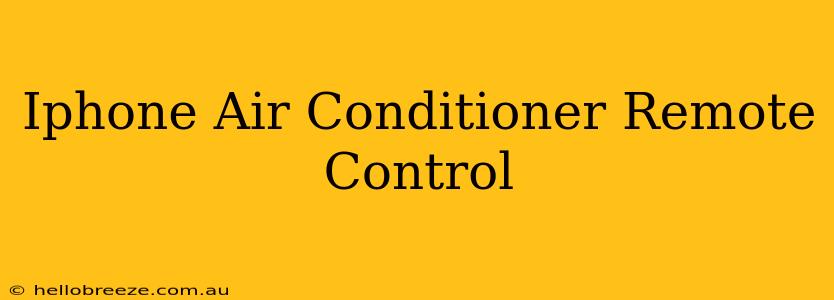Summer heat got you sweating? Tired of fumbling with your air conditioner's remote? Then you'll love the convenience of controlling your AC directly from your iPhone! This guide will walk you through the options available for turning your iPhone into a powerful air conditioner remote control.
Finding the Right App for Your AC Unit
The key to successfully controlling your air conditioner with your iPhone is finding a compatible app. Not all apps work with all brands and models. Before downloading anything, check your AC unit's manual or the manufacturer's website to see if they offer an official app or if they're compatible with a specific smart home system.
Popular Options and Considerations:
-
Manufacturer-Specific Apps: Many major air conditioner brands (like LG, Samsung, and Daikin) offer dedicated apps for their smart AC units. These apps usually provide the most seamless integration and feature-rich control. Search your AC brand name + "app" in your app store to find the correct one.
-
Smart Home Platforms: If your AC unit is compatible with a smart home system like Apple HomeKit, Google Home, or Amazon Alexa, you can control it through their respective apps. This often requires a smart plug or a compatible AC unit. This approach offers broader compatibility but may not have all the features of a brand-specific app.
-
Universal Remote Apps: Several apps on the app store claim to be "universal" remote controls, capable of controlling various AC brands. Proceed with caution when using these apps. They may require manual configuration and might not work perfectly with every AC model. Read reviews carefully before downloading.
Setting Up Your iPhone as Your AC Remote
Once you’ve chosen an app, the setup process will vary depending on the app and your AC unit. However, here are some general steps to expect:
1. Download and Install the App:
Find the chosen app in the App Store and install it on your iPhone.
2. Create an Account (If Required):
Many apps require you to create a user account. This allows you to save your AC settings and access them from multiple devices.
3. Connect Your AC Unit:
This is where things get specific. Some apps connect directly to your AC unit via Wi-Fi or Bluetooth. Others require a smart plug as an intermediary. Follow the app’s instructions carefully for this step; it often involves adding your AC unit to the app's network.
4. Test and Customize:
Once connected, test the app's functions. You should be able to control temperature, fan speed, and other settings. Customize settings to your preference and save them for future use.
Beyond Basic Temperature Control: Exploring App Features
Many advanced apps go beyond simple temperature adjustments. Look for apps with these features:
- Scheduling: Set timers and schedules to automatically adjust your AC based on your daily routine. Save energy and money!
- Geofencing: Automatically adjust your AC based on your location. The AC turns on as you approach home and off as you leave.
- Energy Monitoring: Track your AC's energy usage to identify opportunities for energy savings.
- Smart Home Integration: Seamlessly integrate your AC control into your existing smart home ecosystem.
Troubleshooting Common Issues
- Connection Problems: Ensure your iPhone, AC unit, and Wi-Fi router are all functioning correctly. Check for network issues and try restarting your devices.
- Incompatibility: Confirm your AC model is supported by the chosen app.
- App Glitches: Try force-quitting the app or reinstalling it. Check for app updates.
By carefully selecting an appropriate app and following the setup instructions, you can transform your iPhone into a convenient and efficient remote control for your air conditioner, ensuring optimal comfort throughout the year. Stay cool!

